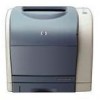HP 2500 HP Color LaserJet 2500 series - User Guide - Page 52
Using color, HP ImageREt 2400
 |
View all HP 2500 manuals
Add to My Manuals
Save this manual to your list of manuals |
Page 52 highlights
Using color This printer offers great color as soon as you set it up. It provides a combination of automatic color features to generate excellent color results for the general user, plus sophisticated tools for the experienced color user. The printer provides carefully designed and tested color tables to provide smooth, accurate color rendition of all printable colors. The printer also offers these capabilities to help manage color: q HP ImageREt 2400 q HP ColorSmart q Managing color options q Matching colors q Printing in four-colors (CMYK) HP ImageREt 2400 HP ImageREt 2400 is a technology that provides you with the best color print-quality without having to change driver settings or make tradeoffs between print quality, performance, and memory. ImageREt 2400 produces sharp images and crisp, clear text using laser printing. ImageREt 2400 provides 2400 dpi color laser-class quality through a multilevel printing process. This process precisely controls color by combining up to four colors within a single dot and by varying the amount of toner in a given area. As a result, ImageREt 2400, together with the 600-by-600 engine resolution, creates millions of smooth colors. In contrast, the single-level printing process found in the default mode of other color laser printers does not allow the colors to be mixed within a single dot. This process, called dithering, significantly hinders the ability to create a wide range of colors without reduced sharpness or visible dot structure. 50 Printing tasks ENWW















